Optical Effects Induced by Bloch Surface Waves in One-Dimensional Photonic Crystals
Abstract
:1. Introduction
2. Reflectance
3. Vizualization and Scattering
4. The Goos–Hänchen Effect Driven by the BSW
5. The BSW-Induced Magneto-Optics
6. The BSW Application in Microparticle Optical Trapping
7. Conclusions
Acknowledgments
Conflicts of Interest
References
- Yeh, P.; Yariv, A. Optical Surface waves in periodic layered media. Appl. Phys. Lett. 1978, 32, 104–105. [Google Scholar] [CrossRef]
- Robertson, W.M.; May, M.S. Surface electromagnetic wave excitation on one-dimensional photonic band gap arrays. Appl. Phys. Lett. 1999, 74, 1800–1802. [Google Scholar] [CrossRef]
- Agranovich, V.; Mills, D. (Eds.) Surface Polaritons: Electromagnetic Waves at Surfaces and Interfaces; Modern Problems in Condensed Matter Sciences; Elsevier: Amsterdam, The Netherlands, 1982; Volume 1. [Google Scholar]
- Han, Z.; Bozhevolnyi, S.I. Chapter 5—Waveguiding with Surface Plasmon Polaritons. In Modern Plasmonics; Richardson, N., Holloway, S., Eds.; Handbook of Surface Science; North-Holland: Amsterdam, The Netherlands, 2014; Volume 4, pp. 137–187. [Google Scholar]
- Dubey, R.; Barakat, E.; Häyrinen, M.; Roussey, M.; Honkanen, S.K.; Kuittinen, M.; Herzig, H.P. Experimental investigation of the propagation properties of bloch surface waves on dielectric multilayer platform. J. Eur. Opt. Soc.-Rapid Publ. 2017, 13, 5. [Google Scholar] [CrossRef]
- Badugu, R.; Mao, J.; Blair, S.; Zhang, D.; Descrovi, E.; Angelini, A.; Huo, Y.; Lakowicz, J.R. Bloch Surface Wave-Coupled Emission at Ultraviolet Wavelengths. J. Phys. Chem. C 2016, 120, 28727–28734. [Google Scholar]
- Kim, M.S.; Lahijani, B.V.; Descharmes, N.; Straubel, J.; Negredo, F.; Rockstuhl, C.; Häyrinen, M.; Kuittinen, M.; Roussey, M.; Herzig, H.P. Subwavelength Focusing of Bloch Surface Waves. ACS Photonics 2017, 4, 1477–1483. [Google Scholar] [CrossRef]
- Konopsky, V.N.; Alieva, E.V. A biosensor based on photonic crystal surface waves with an independent registration of the liquid refractive index. Biosens. Bioelectron. 2010, 25, 1212–1216. [Google Scholar] [CrossRef] [PubMed]
- Konopsky, V.; Karakouz, T.; Alieva, E.V.; Vicario, C.; Sekatskii, S.K.; Dietler, G. Photonic Crystal Biosensor based on Optical Surface Waves. Sensors (Basel) 2013, 13, 2566–2578. [Google Scholar] [CrossRef] [PubMed]
- Li, Y.; Yang, T.; Song, S.; Pang, Z.; Du, G.; Han, S. Phase properties of Bloch surface waves and their sensing applications. Appl. Phys. Lett. 2013, 103, 1–4. [Google Scholar] [CrossRef]
- Sinibaldi, A.; Anopchenko, A.; Rizzo, R.; Danz, N.; Munzert, P.; Rivolo, P.; Frascella, F.; Ricciardi, S.; Michelotti, F. Angularly resolved ellipsometric optical biosensing by means of Bloch surface waves. Anal. Bioanal. Chem. 2015, 407, 3965–3974. [Google Scholar] [CrossRef] [PubMed]
- Descrovi, E.; Frascella, F.; Sciacca, B.; Geobaldo, F. Coupling of surface waves in highly defined one-dimensional porous silicon photonic crystals for gas sensing applications. Appl. Phys. Lett. 2007, 91, 241109–241111. [Google Scholar] [CrossRef]
- Michelotti, F.; Sciacca, B.; Dominici, L.; Quaglio, M.; Descrovi, E.; Giorgis, F.; Geobaldo, F. Fast optical vapour sensing by Bloch surface waves on porous silicon membranes. Phys. Chem. Chem. Phys. 2010, 12, 502–506. [Google Scholar] [CrossRef] [PubMed]
- Descrovi, E.; Giorgis, F.; Dominici, L.; Michelotti, F. Experimental observation of optical bandgaps surface electromagnetic waves periodically corrugated one-dimensional nitride photonic crystal. Opt. Lett. 2008, 33, 243–245. [Google Scholar] [CrossRef] [PubMed]
- Sfez, T.; Descrovi, E.; Dominici, L.; Nakagawa, W.; Michelotti, F.; Giorgis, F.; Herzig, H. Near-field analysis of surface electromagnetic waves in the bandgap region of a polymeric grating written on a one-dimensional photonic crystal. Appl. Phys. Lett. 2008, 93, 061108. [Google Scholar] [CrossRef]
- Kovalevich, T.; Boyer, P.; Suarez, M.; Salut, R.; Kim, M.S.; Herzig, H.P.; Bernal, M.P.; Grosjean, T. Polarization controlled directional propagation of Bloch surface wave. Opt. Express 2017, 25, 5710–5715. [Google Scholar] [CrossRef] [PubMed]
- Wang, R.; Wang, Y.; Zhang, D.; Si, G.; Zhu, L.; Du, L.; Kou, S.; Badugu, R.; Rosenfeld, M.; Lin, J.; Wang, P.; Ming, H.; Yuan, X.; Lakowicz, J. Diffraction-Free Bloch Surface Waves. ACS Nano 2017, 11, 5383–5390. [Google Scholar] [CrossRef] [PubMed]
- Angelini, A.; Barakat, E.; Munzert, P.; Boarino, L.; De Leo, N.; Enrico, E.; Giorgis, F.; Herzig, H.P.; Pirri, C.F.; Descrovi, E. Focusing and Extraction of Light mediated by Bloch Surface Waves. Sci. Rep. 2014, 4, 5428. [Google Scholar] [CrossRef] [PubMed]
- Descrovi, E.; Barakat, E.; Angelini, A.; Munzert, P.; Leo, N.D.; Boarino, L.; Giorgis, F.; Herzig, H.P. Leakage radiation interference microscopy. Opt. Lett. 2013, 38, 3374–3376. [Google Scholar] [CrossRef] [PubMed]
- Hung, Y.J.; Lin, I.S. Visualization of Bloch surface waves and directional propagation effects on one-dimensional photonic crystal substrate. Opt. Express 2016, 24, 16003–16009. [Google Scholar] [CrossRef] [PubMed]
- Yu, L.; Barakat, E.; Sfez, T.; Hvozdara, L.; Di Francesco, J.; Herzig, H.P. Manipulating Bloch surface waves in 2D: A platform concept-based flat lens. Light Sci. Appl. 2014, 3, e124. [Google Scholar] [CrossRef]
- Yeh, P.; Yariv, A.; Hong, C.S. Electromagnetic propagation in periodic stratified media. I. General theory. J. Opt. Soc. Am. 1977, 67, 423–438. [Google Scholar] [CrossRef]
- Soboleva, I.V.; Descrovi, E.; Dominici, L.; Michelotti, F.; Giorgis, F.; Fedyanin, A.A. Visualization of surface electromagnetic waves in one-dimensional photonic crystal by fluorescence dye. Proc. SPIE 2009, 7356, 73560E. [Google Scholar] [CrossRef]
- Meade, R.; Brommer, K.; Rappe, M.; Joannopoulos, J. Electromagnetic Bloch waves at the surface of a photonic crystal. Phys. Rew. B 1991, 44, 10961. [Google Scholar] [CrossRef]
- Michelotti, F.; Sinibaldi, A.; Munzert, P.; Danz, N.; Descrovi, E. Probing losses of dielectric multilayers by means of Bloch surface waves. Opt. Lett. 2013, 38, 616–618. [Google Scholar] [CrossRef] [PubMed]
- Soboleva, I.; Moskalenko, V.; Fedyanin, A. Giant Goos-Hanchen effect and Fano resonance at photonic crystal surfaces. Phys. Rev. Lett. 2012, 108, 123901. [Google Scholar] [CrossRef] [PubMed]
- Raether, H. Surface-Plasmons on Smooth and Rough Surfaces and on Gratings; Springer: Berlin, Germany, 1988. [Google Scholar]
- Moskalenko, V.; Soboleva, I.; Fedyanin, A. Surface waves-induced Goos-Hanchen effect enhancement in one-dimensional photonic crystals. JETP Lett. 2010, 91, 382–386. [Google Scholar] [CrossRef]
- Soboleva, I.; Descrovi, E.; Summonte, C.; Fedyanin, A.A.; Giorgis, F. Fluorescence emission enhanced by surface electromagnetic waves on one-dimensional photonic crystals. Appl. Phys. Lett. 2009, 94, 231122. [Google Scholar] [CrossRef]
- Goos, F.; Hänchen, H. Ein neuer und fundamentaler Versuch zur Totalreflexion. Ann. Phys. 1947, 436, 333–346. [Google Scholar] [CrossRef]
- De Haan, V.O.; Plomp, J.; Rekveldt, T.M.; Kraan, W.H.; van Well, A.A.; Dalgliesh, R.M.; Langridge, S. Observation of the Goos-Hänchen Shift with Neutrons. Phys. Rev. Lett. 2010, 104, 010401. [Google Scholar] [CrossRef] [PubMed]
- Wu, Z.; Zhai, F.; Peeters, F.M.; Xu, H.Q.; Chang, K. Valley-Dependent Brewster Angles and Goos-Hänchen Effect in Strained Graphene. Phys. Rev. Lett. 2011, 106, 176802. [Google Scholar] [CrossRef] [PubMed]
- Wild, W.; Giles, C. Goos-Hänchen shift from absorbing media. Phys. Rev. A 1982, 25, 2099–2101. [Google Scholar] [CrossRef]
- Merano, M.; Aiello, A.; Hooft, T.; Exter, M.P.; Eliel, E.R.; Woerdman, J.P. Observation of Goos-Hänchen shifts in metallic reflection. Opt. Express 2007, 15, 15928–15934. [Google Scholar] [CrossRef] [PubMed]
- Shadrivov, I.V.; Zharov, A.A.; Kivshar, Y.S. Giant Goos-Hänchen effect at the reflection from left-handed metamaterials. Appl. Phys. Lett. 2003, 83, 2713–2715. [Google Scholar] [CrossRef]
- Bonnet, C.; Chauvat, D.; Emile, O.; Bretenaker, F.; Floch, A.L. Measurement of positive and negative Goos-Hänchen effects for metallic gratings near Wood anomalies. Opt. Lett. 2001, 26, 666–668. [Google Scholar] [CrossRef] [PubMed]
- Artmann, K. Berechnung der Seitenversetzung des totalreflektierten Strahles. Ann. Phys. 1948, 437, 87–102. [Google Scholar] [CrossRef]
- Lai, H.M.; Chan, S.W. Large and negative Goos–Hänchen shift near the Brewster dip on reflection from weakly absorbing media. Opt. Lett. 2002, 27, 680–682. [Google Scholar] [CrossRef] [PubMed]
- Felbacq, D.; Moreau, A.; Smaâli, R. Goos-Hänchen effect in the gaps of photonic crystals. Opt. Lett. 2003, 28, 1633–1635. [Google Scholar] [CrossRef] [PubMed]
- Yin, X.; Hesselink, L.; Liu, Z.; Fang, N.; Zhang, X. Large positive and negative lateral optical beam displacements due to surface plasmon resonance. Appl. Phys. Lett. 2004, 85, 372–374. [Google Scholar] [CrossRef]
- Wan, Y.; Zheng, Z.; Kong, W.; Zhao, X.; Liu, Y.; Bian, Y.; Liu, J. Nearly three orders of magnitude enhancement of Goos-Hanchen shift by exciting Bloch surface wave. Opt. Express 2012, 20, 8998–9003. [Google Scholar] [CrossRef] [PubMed]
- Chen, C.; Lin, W.; Liao, L.; Lin, Z.; Chiang, H.; Leung, P.; Sijercic, E.; Tse, W. Optical temperature sensing based on the Goos-Hänchen effect. Appl. Opt. 2007, 46, 5347–5351. [Google Scholar] [CrossRef] [PubMed]
- Yin, X.; Hesselin, L. Goos-Hänchen shift surface plasmon resonance sensor. Appl. Phys. Lett. 2006, 89, 261108. [Google Scholar] [CrossRef]
- Inoue, M.; Fujikawa, R.; Baryshev, A.; Khanikaev, A.; Lim, P.B.; Uchida, H.; Aktsipetrov, O.; Fedyanin, A.; Murzina, T.; Granovsky, A. Magnetophotonic crystals. J. Phys. D Appl. Phys. 2006, 39, R151. [Google Scholar] [CrossRef]
- Belotelov, V.I.; Akimov, I.A.; Pohl, M.; Kotov, V.A.; Kasture, S.; Vengurlekar, A.S.; Gopal, A.V.; Yakovlev, D.R.; Zvezdin, A.K.; Bayer, M. Enhanced magneto-optical effects in magnetoplasmonic crystals. Nat. Nanotechnol. 2011, 6, 370–376. [Google Scholar] [CrossRef] [PubMed]
- Inoue, M.; Fujii, T. A theoretical analysis of magneto-optical Faraday effect of YIG films with random multilayer structures. J. Appl. Phys. 1997, 81, 5659. [Google Scholar] [CrossRef]
- Fedyanin, A.A.; Yoshida, T.; Nishimura, K.; Marowsky, G.; Inoue, M.; Aktsipetrov, O.A. Nonlinear magneto-optical Kerr effect in gyrotropic photonic band gap structures: Magneto-photonic microcavities. J. Magn. Magn. Mater. 2003, 258–259, 96–98. [Google Scholar] [CrossRef]
- Goto, T.; Dorofeenko, A.V.; Merzlikin, A.M.; Baryshev, A.V.; Vinogradov, A.P.; Inoue, M.; Lisyansky, A.A.; Granovsky, A.B. Optical Tamm States in One-Dimensional Magnetophotonic Structures. Phys. Rev. Lett. 2008, 101, 113902. [Google Scholar] [CrossRef] [PubMed]
- Grunin, A.A.; Zhdanov, A.G.; Ezhov, A.A.; Ganshina, E.A.; Fedyanin, A.A. Surface-plasmon-induced enhancement of magneto-optical Kerr effect in all-nickel subwavelength nanogratings. Appl. Phys. Lett. 2010, 97, 261908. [Google Scholar] [CrossRef]
- Clavero, C.; Yang, K.; Skuza, J.R.; Lukaszew, R.A. Magnetic field modulation of intense surface plasmon polaritons. Opt. Express 2010, 18, 7743–7752. [Google Scholar] [CrossRef] [PubMed]
- Chin, J.Y.; Steinle, T.; Wehlus, T.; Dregely, D.; Weiss, T.; Belotelov, V.I.; Stritzker, B.; Giessen, H. Nonreciprocal plasmonics enables giant enhancement of thin-film Faraday rotation. Nat. Commun. 2013, 4, 1599. [Google Scholar] [CrossRef] [PubMed]
- Romodina, M.N.; Soboleva, I.V.; Fedyanin, A.A. Magneto-optical switching of Bloch surface waves in magnetophotonic crystals. J. Magn. Magn. Mater. 2016, 415, 82–86. [Google Scholar] [CrossRef]
- Romodina, M.N.; Soboleva, I.V.; Musorin, A.I.; Nakamura, Y.; Inoue, M.; Fedyanin, A.A. Bloch-surface-wave-induced Fano resonance in magnetophotonic crystals. Phys. Rev. B 2017, 96, 081401(R). [Google Scholar] [CrossRef]
- Berreman, D.W. Optics in Stratified and Anisotropic Media: 4x4-Matrix Formulation. J. Opt. Soc. Am. 1972, 62, 502–510. [Google Scholar] [CrossRef]
- Bethune, D.S. Optical harmonic generation and mixing in multilayer media: Extension of optical transfer matrix approach to include anisotropic materials. J. Opt. Soc. Am. B 1991, 8, 367–373. [Google Scholar] [CrossRef]
- Inoue, M.; Levy, M.; Baryshev, A.V. Magnetophotonics: From Theory to Applications; Springer: Berlin, Germany, 2008; Volume 104. [Google Scholar]
- Ashkin, A. Acceleration and Trapping of Particles by Radiation Pressure. Phys. Rev. Lett. 1970, 24, 156–159. [Google Scholar] [CrossRef]
- Ashkin, A.; Dziedzic, J.M. Optical levitation by radiation pressure. Appl. Phys. Lett. 1971, 19, 283–285. [Google Scholar] [CrossRef]
- Ashkin, A.; Dziedzic, J.M.; Bjorkholm, J.E.; Chu, S. Observation of a single-beam gradient force optical trap for dielectric particles. Opt. Lett. 1986, 11, 288–290. [Google Scholar] [CrossRef] [PubMed]
- Ashkin, A.; Dziedzic, J.M.; Yamane, T. Optical trapping and manipulation of single cells using infrared laser beams. Nature 1987, 330, 769–771. [Google Scholar] [CrossRef] [PubMed]
- Ashkin, A.; Dziedzic, J. Optical trapping and manipulation of viruses and bacteria. Science 1987, 235, 1517–1520. [Google Scholar] [CrossRef] [PubMed]
- Neuman, K.C.; Block, S.M. Optical trapping. Rev. Sci. Instrum. 2004, 75, 2787–2809. [Google Scholar] [CrossRef] [PubMed]
- McGloin, D. Optical tweezers: 20 years on. Philos. Trans. R. Soc. A: Math. Phys. Eng. Sci. 2006, 364, 3521–3537. [Google Scholar] [CrossRef] [PubMed]
- Kawata, S.; Sugiura, T. Movement of micrometer-sized particles in the evanescent field of a laser beam. Opt. Lett. 1992, 17, 772–774. [Google Scholar] [CrossRef] [PubMed]
- Wada, K.I.; Sasaki, K.; Masuhara, H. Optical measurement of interaction potentials between a single microparticle and an evanescent field. Appl. Phys. Lett. 2000, 76, 2815–2817. [Google Scholar] [CrossRef]
- Gaugiran, S.; Gétin, S.; Fedeli, J.M.; Colas, G.; Fuchs, A.; Chatelain, F.; Dérouard, J. Optical manipulation of microparticles and cells on silicon nitride waveguides. Opt. Express 2005, 13, 6956–6963. [Google Scholar] [CrossRef] [PubMed]
- Ng, L.; Luff, B.; Zervas, M.; Wilkinson, J. Forces on a Rayleigh particle in the cover region of a planar waveguide. J. Lightw. Technol. 2000, 18, 388–400. [Google Scholar] [CrossRef]
- Juan, M.L.; Righini, M.; Quidant, R. Plasmon nano-optical tweezers. Nat. Photonics 2011, 5, 349–356. [Google Scholar] [CrossRef]
- Wong, H.M.K.; Righini, M.; Gates, J.C.; Smith, P.G.R.; Pruneri, V.; Quidant, R. On-a-chip surface plasmon tweezers. Appl. Phys. Lett. 2011, 99, 061107. [Google Scholar] [CrossRef]
- Zelenina, A.S.; Quidant, R.; Badenes, G.; Nieto-Vesperinas, M. Tunable optical sorting and manipulation of nanoparticles via plasmon excitation. Opt. Lett. 2006, 31, 2054–2056. [Google Scholar] [CrossRef] [PubMed]
- Volpe, G.; Quidant, R.; Badenes, G.; Petrov, D. Surface Plasmon Radiation Forces. Phys. Rev. Lett. 2006, 96, 238101. [Google Scholar] [CrossRef] [PubMed]
- Righini, M.; Volpe, G.; Girard, C.; Petrov, D.; Quidant, R. Surface Plasmon Optical Tweezers: Tunable Optical Manipulation in the Femtonewton Range. Phys. Rev. Lett. 2008, 100, 186804. [Google Scholar] [CrossRef] [PubMed]
- Grigorenko, A.N.; Roberts, N.W.; Dickinson, M.R.; Zhang, Y. Nanometric optical tweezers based on nanostructured substrates. Nat. Photonics 2008, 2, 365–370. [Google Scholar] [CrossRef]
- Shilkin, D.; Lyubin, E.; Soboleva, I.; Fedyanin, A. Trap position control in the vicinity of reflecting surfaces in optical tweezers. JETP Lett. 2014, 98, 644–647. [Google Scholar] [CrossRef]
- Shilkin, D.A.; Lyubin, E.V.; Soboleva, I.V.; Fedyanin, A.A. Direct measurements of forces induced by Bloch surface waves in a one-dimensional photonic crystal. Opt. Lett. 2015, 40, 4883–4886. [Google Scholar] [CrossRef] [PubMed]
- Shilkin, D.; Lyubin, E.; Soboleva, I.; Fedyanin, A. Near- field probing of Bloch surface waves in a dielectric multilayer using photonic force microscopy. J. Opt. Soc. Am. B 2016, 33, 1120–1127. [Google Scholar] [CrossRef]

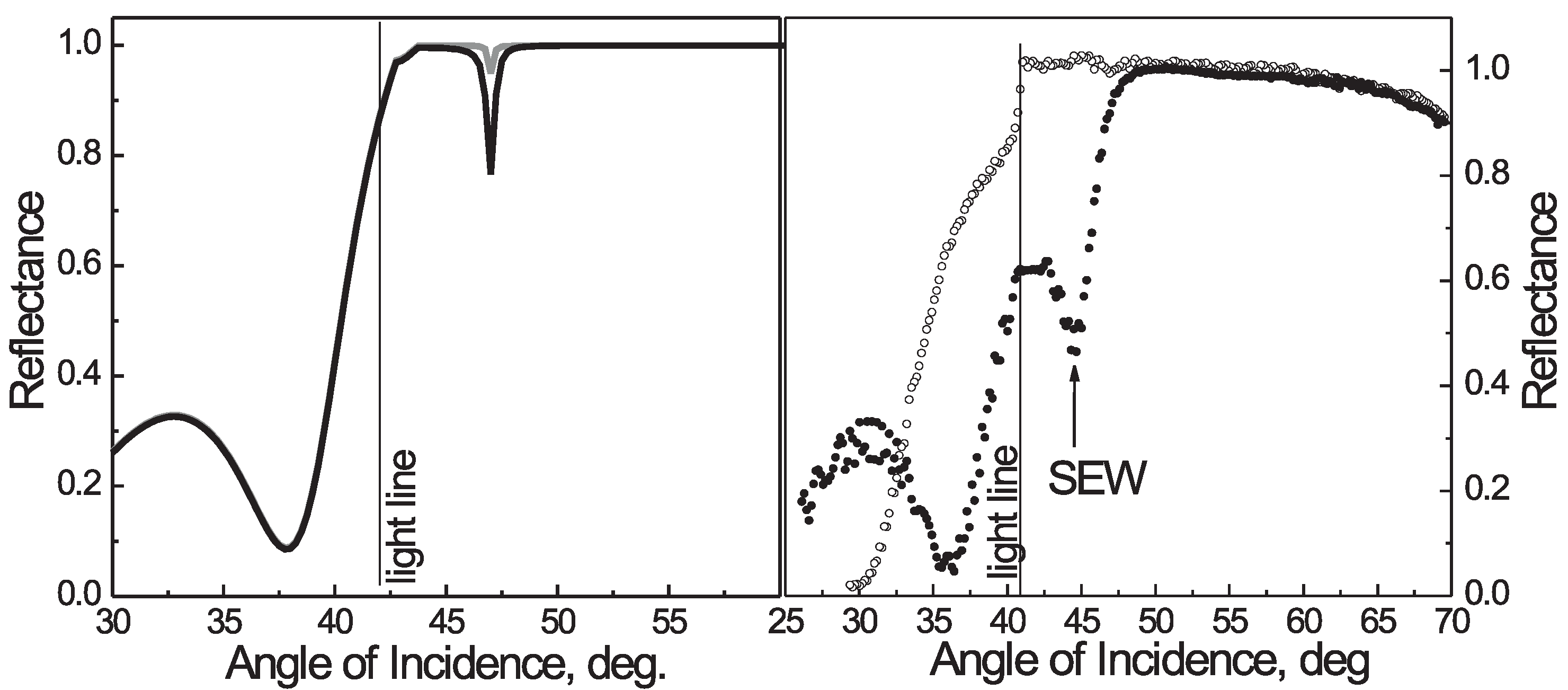
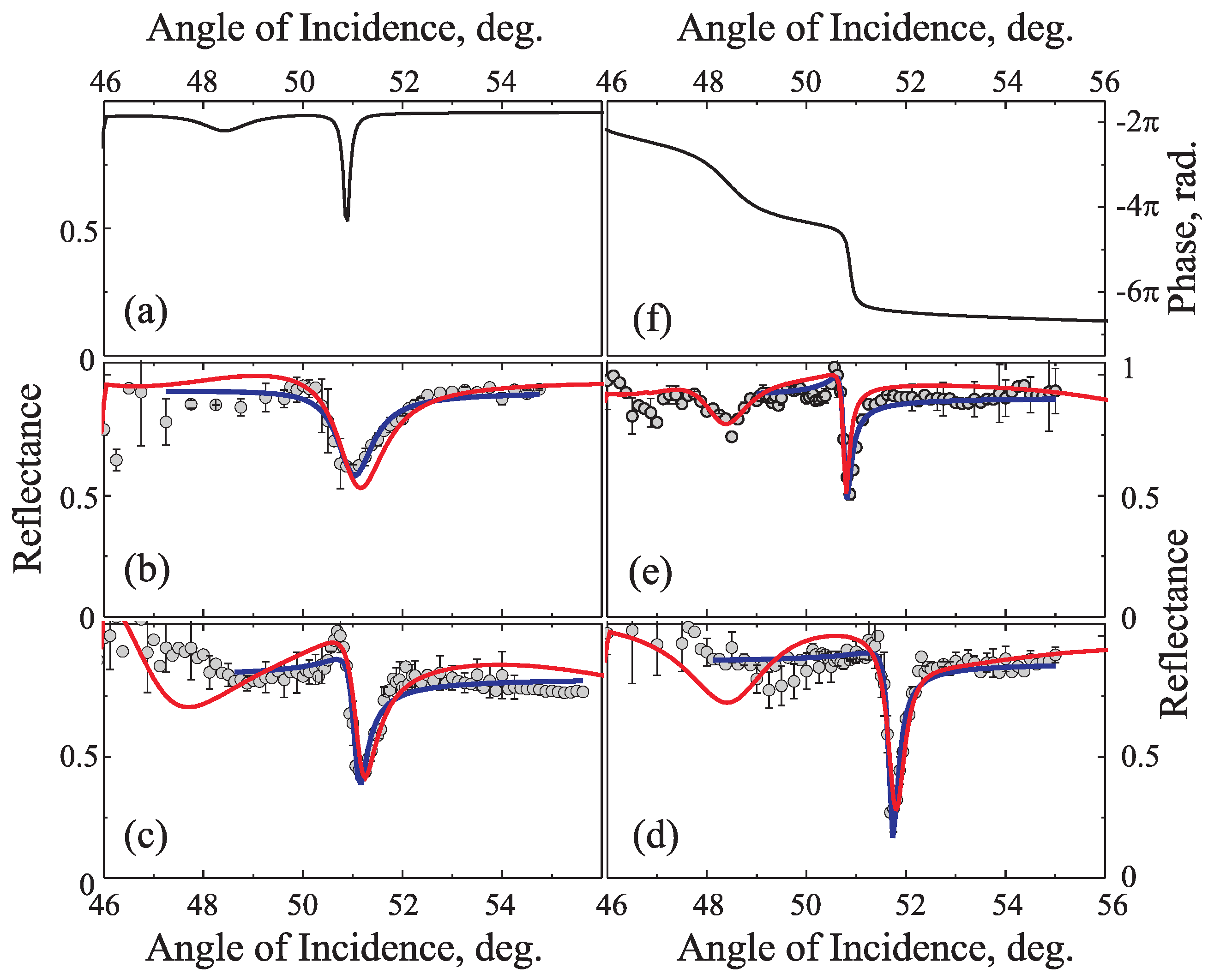
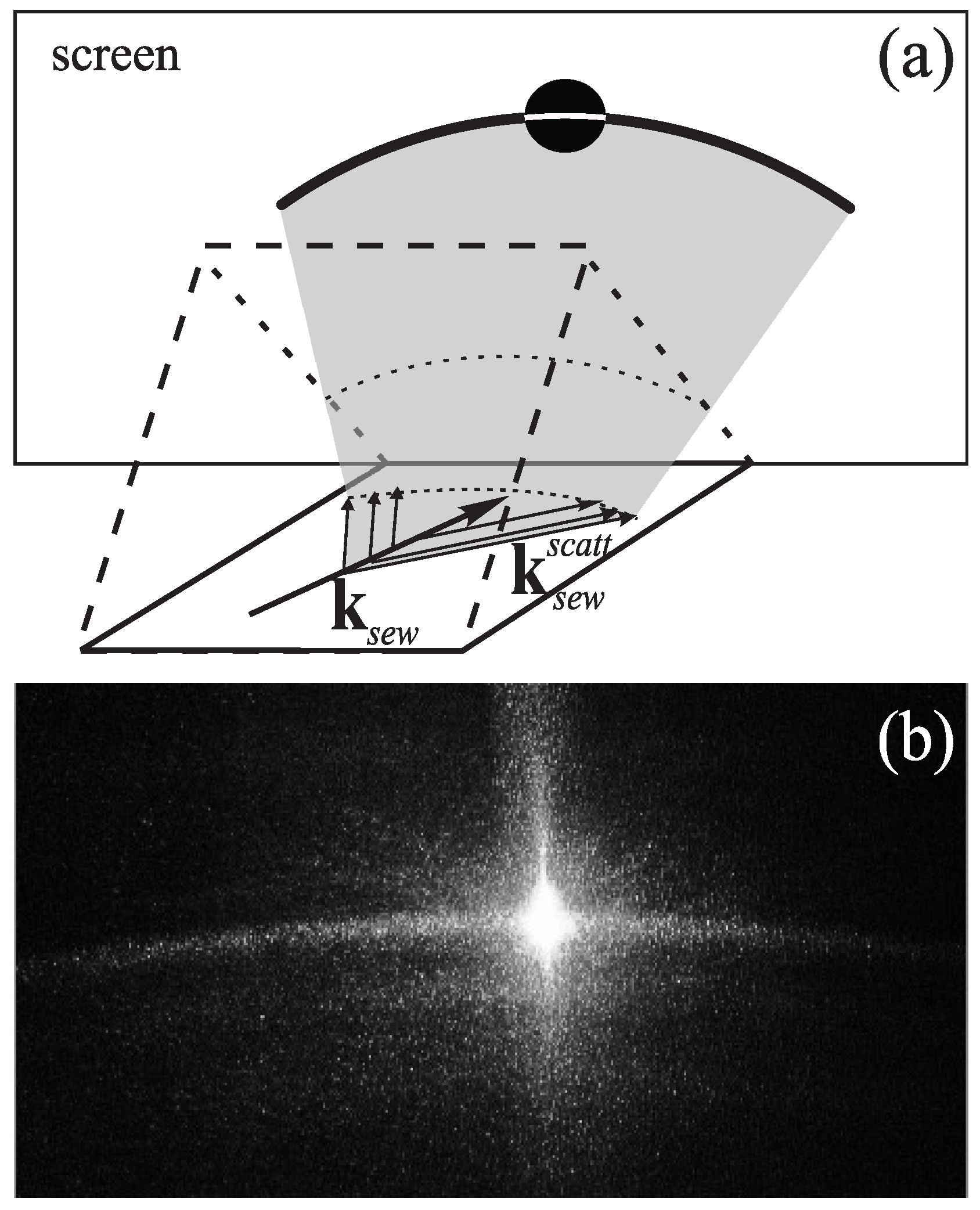
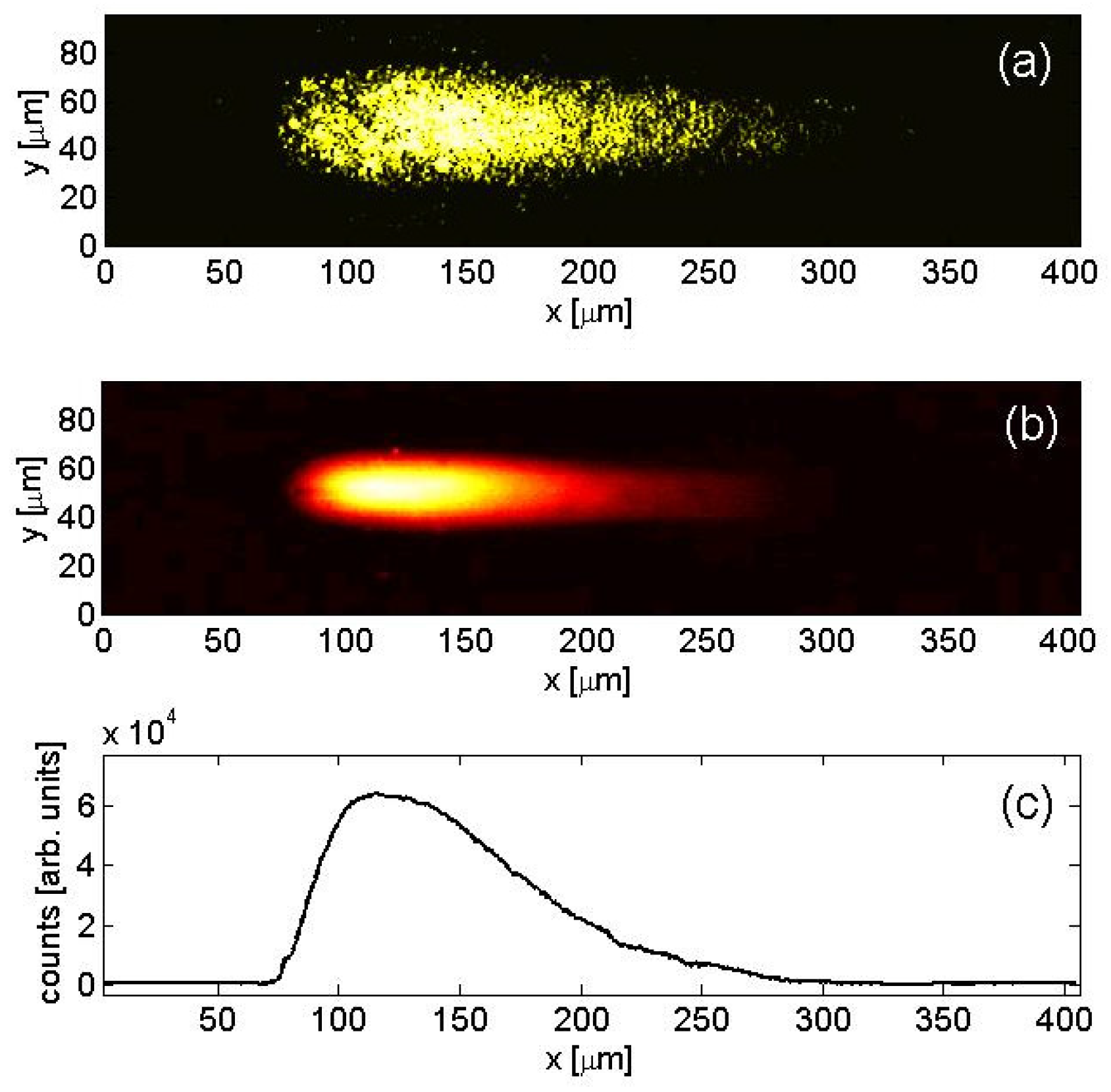

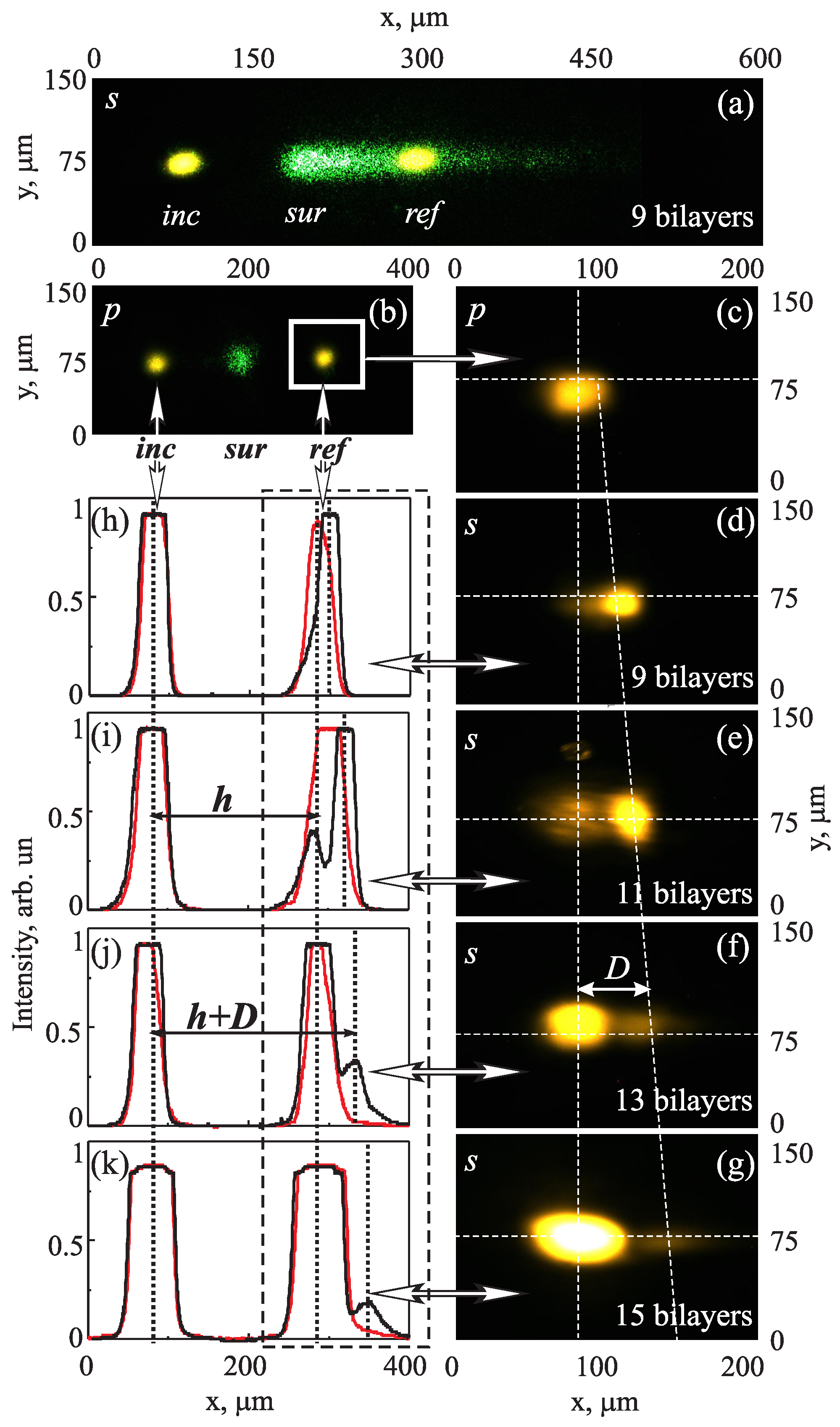


© 2018 by the authors. Licensee MDPI, Basel, Switzerland. This article is an open access article distributed under the terms and conditions of the Creative Commons Attribution (CC BY) license (http://creativecommons.org/licenses/by/4.0/).
Share and Cite
Soboleva, I.V.; Romodina, M.N.; Lyubin, E.V.; Fedyanin, A.A. Optical Effects Induced by Bloch Surface Waves in One-Dimensional Photonic Crystals. Appl. Sci. 2018, 8, 127. https://doi.org/10.3390/app8010127
Soboleva IV, Romodina MN, Lyubin EV, Fedyanin AA. Optical Effects Induced by Bloch Surface Waves in One-Dimensional Photonic Crystals. Applied Sciences. 2018; 8(1):127. https://doi.org/10.3390/app8010127
Chicago/Turabian StyleSoboleva, Irina V., Maria N. Romodina, Evgeny V. Lyubin, and Andrey A. Fedyanin. 2018. "Optical Effects Induced by Bloch Surface Waves in One-Dimensional Photonic Crystals" Applied Sciences 8, no. 1: 127. https://doi.org/10.3390/app8010127




